Below, we look at six patterns of play you can use in the 4-2-3-1 formation.
We will use tactical analysis and coaching to identify four patterns of play.
These include are for wide penetration, while the other two are for central penetration.
If you are coaching the 4-2-3-1 system or participating in any high-level coaching courses such as the UEFA A or B licence, where patterns of play are a requirement, you may find the following valuable.
While developing this series of passing and moving patterns, I share what has worked for me on the training ground as well as taking influence from some of Europe's finest teams who operate in this formation.
In particular, I observed a lot of Arsenal under the early Mikel Arteta era.
The Premier League side have produced a lot of good, fast, fluid, attacking football in the 4-2-3-1 formation, and they have developed a style under the young Spanish manager that any purest of the game would appreciate.
In the below three images, we will use analysis to see a pattern of play which I have detailed below as Pattern: Central B.
In this Premier League clash between Crystal Palace and Arsenal, Mesut Özil, Alexandre Lacazette and Pierre-Emerick Aubameyang (formerly of Borussia Dortmund) combine well to give Arsenal their first goal.

Play begins with a forward pass to Özil, the CAM for Arsenal, who in turn lays-off a soft pass for Lacazette to progress the attack.
In anticipation, LM Aubameyang starts his run.

Due to his movement to lose the centre-back and his positive body shape, Lacazette is best placed to play a penetrating pass.
While Aubameyang continues his run to meet the through ball.

Aubameyang takes an excellent first touch and finishes down low to the goalkeeper's right.
A three-pass combination which resulted in a goal, a goal that would not have been scored if not for the perfect passes, well timed run and good body shape of the attackers.
Below we will look at:
- Why coach patterns of play
- Orientation of the 4-2-3-1
- Wide patterns
- Central patterns
- Getting success
Why coach patterns of play
The bottom line is that we train patterns of play to help players identify and execute pre-determined passing and moving combinations to beat the opponent’s defence.
Sometimes that may mean penetration to score a goal, other times it may also mean playing through the opponents forwards or midfield to get through their defensive block or pressure.
If you are a coach, also consider individual and team confidence.
When the attacking team is only playing in reaction to one another, this means they are trying to discover moments and gaps out of pure randomness to get success.
At the same time, the opponent can anticipate and defend.
The likely outcome is a lot of technical and tactical errors that subsequently result in higher turnovers, which weighs a player's confidence.
On the other hand, when you have a team that knows the system and they can execute plays on minimal touches, and at such a high speed the opponent cannot always react to this, which in turn, offers a higher chance of success.
Orientation of the 4-2-3-1 Formation
The characteristics of a particular formation can only be emphasized by the style of play of the team that uses it.
The 4-2-3-1 is a flexible formation that offers a lot of versatility to possession-based teams that look to create numerical superiority in defence and midfield.
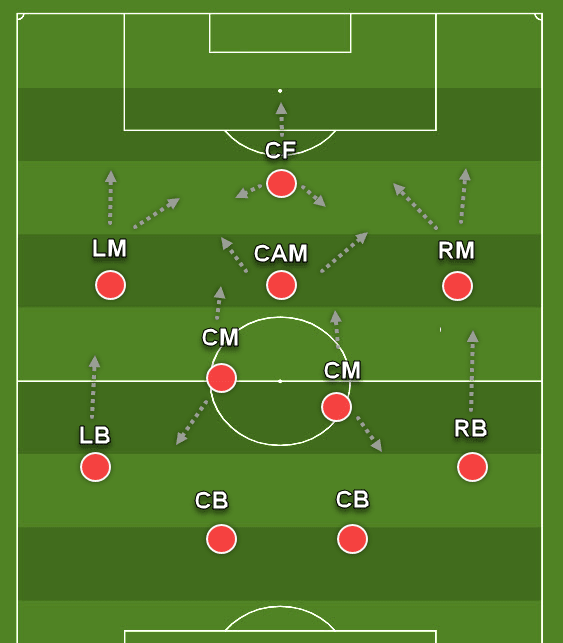
Notice by the graphical annotation each player’s primary and secondary movements in attack represented by the grey arrows.
In the build-up phase, generally, one of the two pivots can drop into the defence to create a false back-three temporarily as the full-backs advance forward.
Higher up the field, with wide midfielders drifting into the half-spaces as well as the two central-midfielders supporting close from behind this helps create numerical superiority as well as optional flexibility in central areas.
As these five players operate centrally, both full-backs can then command their respective channels.
Along with that, the two centre-backs support from behind while the centre-forwards remain the focal point in attack.
The centre-forward operates as a traditional number ‘9’ as a target player, among other functions.
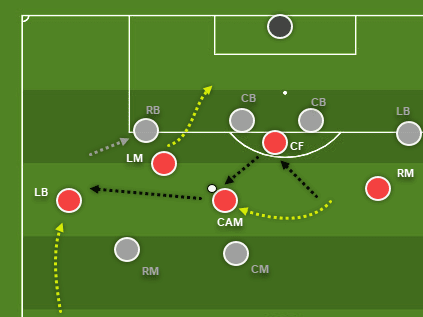
In the above tactical annotation, we see a common game moment where the 4-2-3-1 holds its value.
The CAM has positional flexibility to operate on both sides of the field and also between the lines of the opposition.
This makes him a tougher player to mark; also, the CAM is key in creating overloads and high-value goal-scoring opportunities in the opponent's final third.
Above, the CAM receives a lay-off pass from the CF, the LM makes a penetrating run in the half-space which in turn serves to pull the opposition RB out of position.
This allows the CAM to either play a through ball to the LM if possible or out wide to the LB to continue the attack.
Wide patterns
All patterns can be mirrored on both sides of the field.
The ‘yellow’ icons on the field represent mannequins, so work at your own pace as you may want to gradually introduce one, two, or three defenders along with the mannequins over time.
All patterns of play are set up to play against a back four, as represented by the positioning of the mannequins on the field.
For each pattern of play, I recommend positioning the mannequins in natural defensive positions relative to the play.
These patterns of play develop attacks that penetrate the opposition's defence in wide areas.
From there, you may want to introduce your own crossing and finishing principles or allow freedom for the ball carrier to dribble into the box and determine his own options.
Wide A:
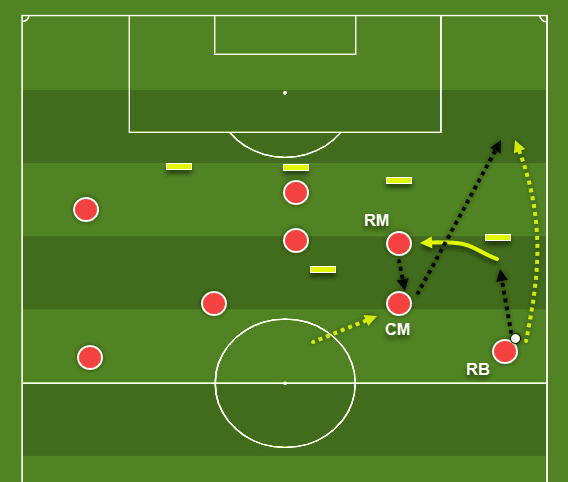
- RB plays forward to the RM; the RM starts wide when receiving the pass
- After the RB makes the initial pass, he makes a run in the channel
- As RM steps inside with the ball to the half-space, the CM moves slightly wide of the RM to receive the ball unmarked and also to offer himself the angle to play the next pass forward
- The timing-movement relationship of the third pass is crucial as the RB needs to receive the pass before going offside, and the CM needs not delay his pass before losing the angle to play forward.
- The RM should try to offer a cushioned pass into the run of the CM so he can play the third and final pass with one-touch
- The RB should hold the width in his run so that he has a good body shape as he receives the through ball.
Wide B:
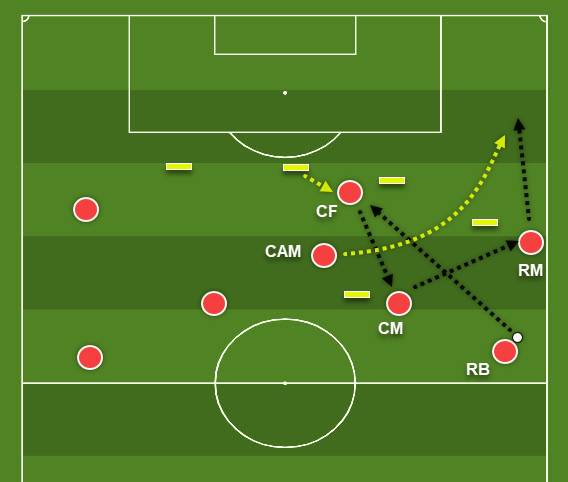
- The RB takes a short touch forward as the trigger for the CF to drop short to receive the pass
- Although it’s a long first pass, the CF should lay off the second pass with one touch if possible
- As the ball is travelling to the CF, the CAM makes an angled run into the channel
- The CF lays off a pass to the CM, who then plays to the RM.
- At this point, the RM will want to offer a high-to-low movement as well as hold the width such that he has both the space and the angle to play the final pass
- Ideally, the CM should give the RM a pass that he can play and subsequently play forward with one touch if possible. The position and body shape are crucial here.
- Again the extra touch can be the killer for the final pass, so the quality of passes is essential.
- The CAM should angle his run to allow himself a higher degree of flexibility as he looks to beat the offside line in meeting the final pass.
- From here, this would set up a good cross-to-finish opportunity.
Wide C:
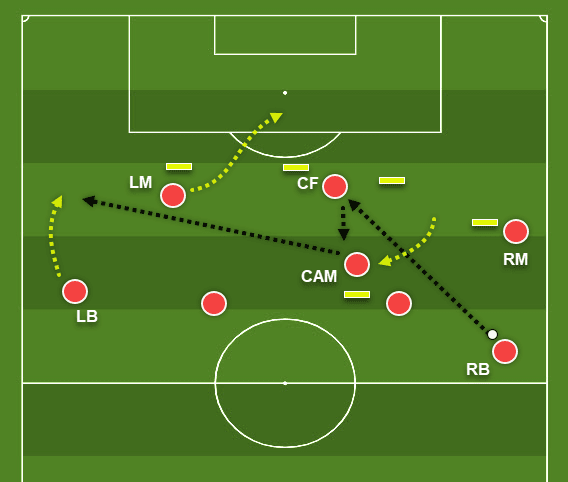
- The RB takes a short touch forward as a trigger for the CF to come short from his highest point to meet the pass
- As the bass is travelling, the CAM makes an angled run in between the lines and at a sufficient distance from the CF
- If the quality of the first pass is good, then the CF can lay off a pass into the run of the CAM with a one-touch
- At this point, the LM should be making his angled run to create a run that would meet a potential penetrating pass. In doing so, the LM would serve to create space for the LB by bringing the opposition full-back with him on his run.
- At this point, the LB should look to cover the ground quickly to get high in support and continue to develop a high-value attack.
Wide D:
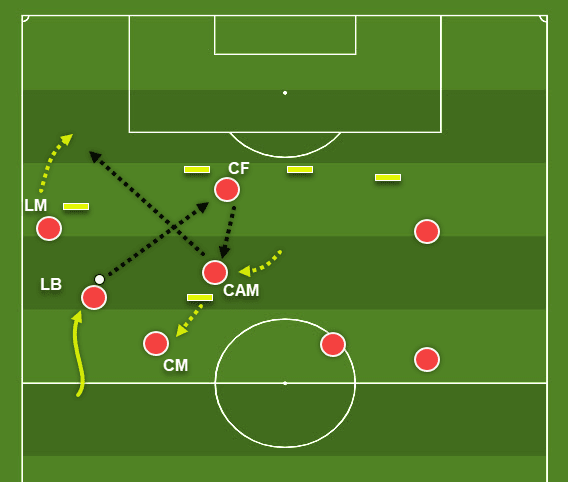
- The LB dribbles forward with the ball at a half pace and with good close control of the ball
- To simulate when an opposition player would engage the press the LB releases the ball at an advanced but realistic position from the half-space
- At the moment the ball should be released from the LB, the CF makes a short run deep to receive the ball unmarked
- Again receiving a good pass from the LB, the CF lays off a short pass to the CAM, who is moving wide of his central position away from pressure
- It is at this point that the LM makes a disguised movement to go deep but then spins the defender on the outside and makes a run forward in the channel
- As the LM cannot afford to slow his run, the CAM must look to play a timely pass forward through the gap to meet the run of the LM before he is offside
- This is a good position to develop a ‘cross’ to ‘finish’ opportunity.
Central patterns
The primary difference between central and wide penetration is that central patterns in the opponent's half generally result in players arriving in good goal-scoring positions.
As for wide patterns that come to fruition, they typically result in wide crossing positions or dribbling opportunities into the box from a wide position.
That is unless the pattern includes the final ball in the box.
Note, all patterns of play can be mirrored to both sides of the field.
Central A:
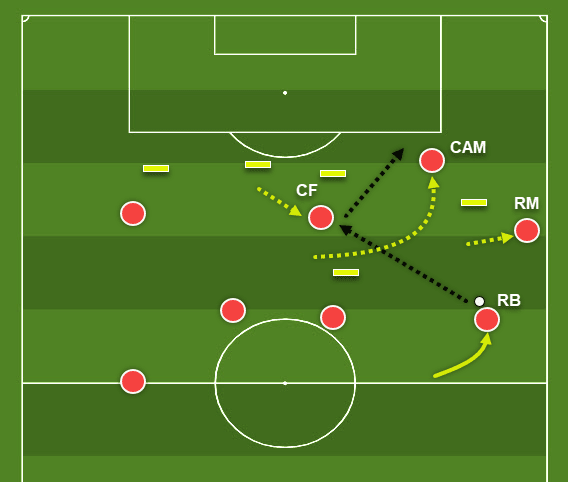
- The RB carries the ball forward in the half-space to develop overall shorter passing distances which in turn will serve to help the passes move at a higher tempo and with greater efficiency
- Unless pressed, the RB should react to play the first pass to the movement of the CF, who makes a sort run-deep
- As the ball is travelling, the CAM’s movement is key, as he needs to arc his run such that he remains at a sufficient distance from the CF to be an option for a pass as well as to help himself have a positive body shape as he meets the final pass facing towards the goal,
- The initial pass has to be a perfect pass to the strikers preferred foot so to allow a one-touch lay off to the CAM.
- The RM must remain wide as he serves to create the width by engaging the opposition full-back as well as being a secondary option should the final pass not be executed
- Passing qualities, as well as timing and movement of the runs, are critical to getting success
Central B:
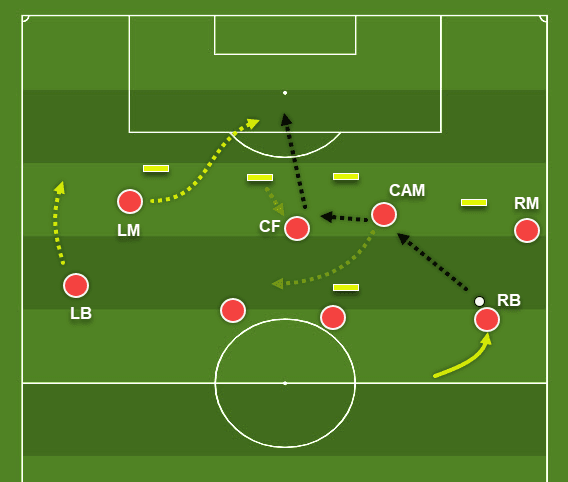
- The RB carries the ball forward in the half-space to an advanced position
- The starting position of the CAM must be high and wider to the CF, which would be a natural staggered position in open play.
- The CAM receives a pass from the RB and if he can play his first touch as a pass to the CF he should
- The CF makes high to low movement away from the CB only moments before the CAM’s pass
- The CF’s body shape is crucial as he should be looking to receive the ball facing the opposition goal.
- It is the subtle and fine details that determine the success, as the CF needs to be late on his run not to be marked and have a good first touch to receive and play forward.
- From the time the CAM passes to the CF, the LM should be making his run at full speed to beat the trailing defender, in this case, the full-back.
- Should the final pass not be available, the supporting LB is also an option that will allow the attack to continue.
- After the CAM plays a pass to the CF, he may also make a curved run around the CF to be an option in the space on the opposite side.
- Passing quality, body shape and well-timed runs cannot be overstated as crucial components for achieving success.
Getting success
The biggest challenge is getting players to identify all at once the trained pattern of play at the same time in a 90-minute match through their tactics.
However, with the right conditions of open play in training, we can develop each player's capacity to read the game and identify those moments.
Take a look at my recent coaching articles: ‘Coaching: Patterns of play in 4-4-2′ as well as ‘Coaching: Patterns of play in 4-3-3′ to see how I coach my players to identify and execute those practised patterns of play in a competitive game.
Options central and wide: We have outlined a total of six options for a team that plays a 4-2-3-1 formation to seek out, create and execute.
Passing qualities, as well as the right timing and movement, will always be basic essentials to success.
In the beginning, when working with your players, narrow it down to one or a maximum of two patterns in a week.
Let them get used to this, learn the pattern well and build confidence.
What-If’s: *This is usually where a coach has to show his value as a mentor, as there will be plenty opportunity for stoppages in the conditioned game, helping the players discover their what-ifs will be crucial for developing a confident possession-based team.
Remember it is essential for players to identify not only their patterns of play but also know their what-ifs, if the desired outcome cannot be reached.
Mindset, repetition and patience: Try not to hurry success too early, the more you handover performance ownership to the player and create the correct mindset within the group the sooner you will see the rewards of this training.
Facilitating a mindset of discovery and problem solving over error avoidance and forcing opportunities will significantly improve the players' learning and help create the desired outcome.
If you enjoyed and found this article valuable, or you still have some questions or want to discover more about patterns of play in the 4-2-3-1 formation, write to me on Twitter @easytactics.
You can read my follow up piece on ‘Attacking with inverted wingers’.

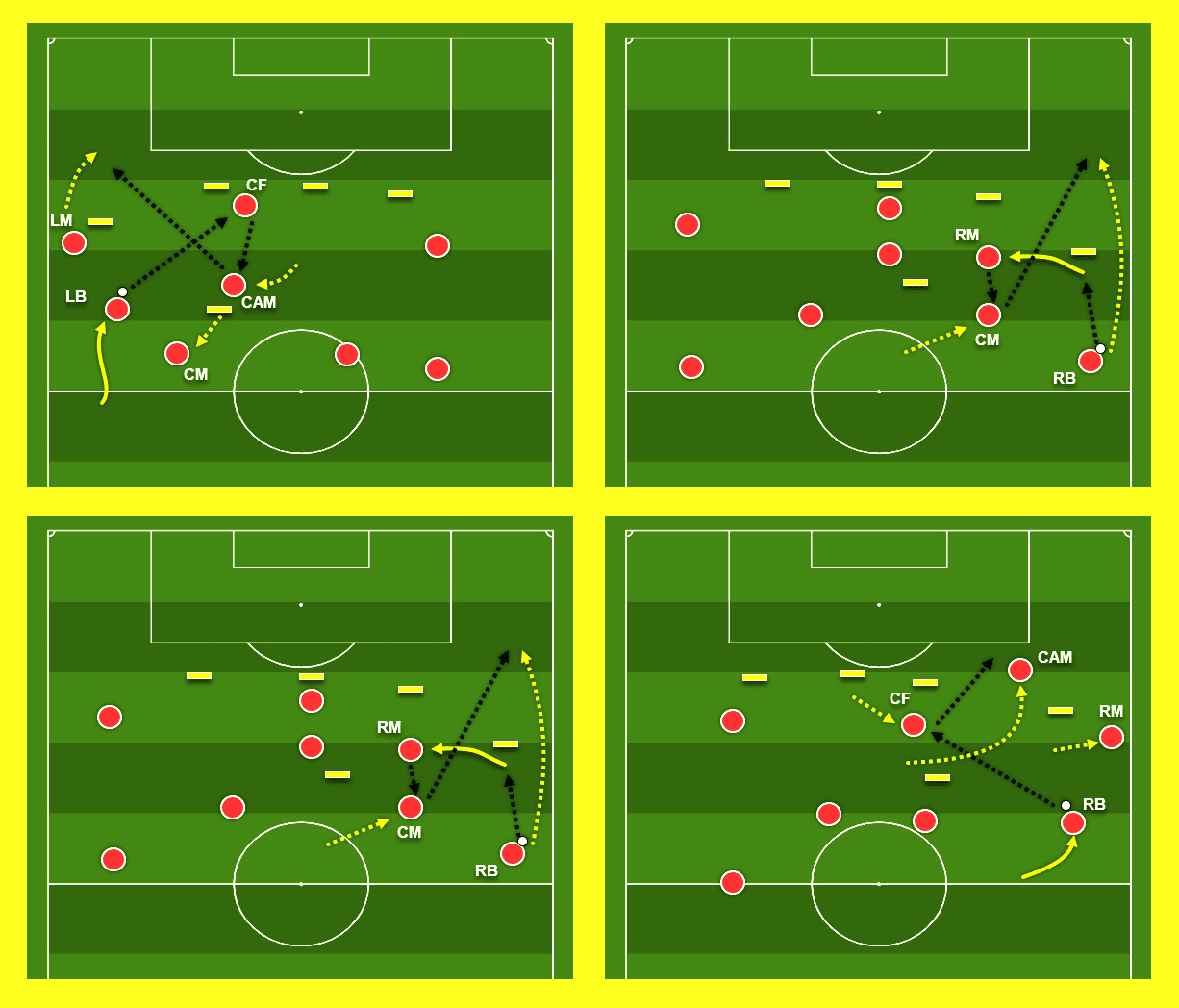



Comments